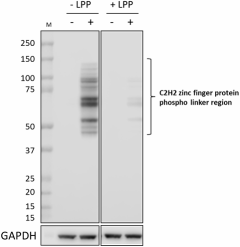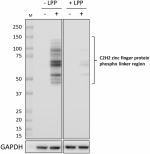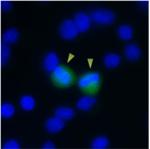- Clone
- 7F8C76 (See other available formats)
- Regulatory Status
- RUO
- Isotype
- Mouse IgG1, κ
- Ave. Rating
- Submit a Review
- Product Citations
- publications

-

Whole cell extracts (15 µg protein) from serum starved HeLa untreated (-) or treated (+) with 200 ng/mL Nocodazole for 20 hrs were resolved on a 4-12% Bis-Tris gel and transferred to a PVDF membrane. The membrane was treated (+ LPP) or untreated (- LPP) with lambda protein phosphatase, overnight at 4°C and probed with 1.0 µg/mL (1:500 dilution) of purified anti-C2H2 zinc finger protein phospho linker region (HpTGEKP), clone 7F8C76, 2 hrs at RT. Proteins were visualized by chemiluminescence detection using HRP goat anti-mouse IgG antibody (Cat. No. 405306) at a 1:3000 dilution. Direct-Blot™ HRP anti GAPDH Antibody (Cat. No. 607904) was used as a loading control at a 1:25000 dilution (lower). Lane M: Molecular Weight marker. -

Asynchronized HeLa cells were stained with purified anti-C2H2 zinc finger protein phospho linker region (HpTGEKP) antibody, followed by staining with DyLight™ 488 conjugated goat anti-mouse IgG (green) antibody and DAPI (blue). The arrow heads indicate mitotic HeLa cells.
| Cat # | Size | Price | Quantity Check Availability | Save | ||
|---|---|---|---|---|---|---|
| 678902 | 100 µg | 335 CHF | ||||
C2H2 zinc finger proteins (ZFPs) are DNA-binding transcription factors that regulate a variety of biological processes such as cellular growth, differentiation, and proliferation. A zinc finger protein can contain several tandems of clustered zinc finger motifs responsible for DNA binding. However, stable ZFP binding to DNA requires the conserved linker sequences that join adjacent zinc fingers. These linkers participate in wrapping of the ZFP around the double helix of DNA, which is required for efficient binding. Most of the ZFP linkers contain the same amino acid sequence HTGEKP, which has been shown to be phosphorylated at the threonine residue by TOPK/PBK during mitosis. Phosphorylation on the linker sequence of ZFP leads to the inactivation of DNA binding activity.
Product DetailsProduct Details
- Verified Reactivity
- Human
- Antibody Type
- Monoclonal
- Host Species
- Mouse
- Immunogen
- Peptide (HQRIH(pT)GEKPYKC) conjugated to KLH.
- Formulation
- Phosphate-buffered solution, pH 7.2, containing 0.09% sodium azide.
- Preparation
- The antibody was purified by affinity chromatography.
- Concentration
- 0.5 mg/ml
- Storage & Handling
- The antibody solution should be stored undiluted between 2°C and 8°C.
- Application
-
WB - Quality tested
ICC - Verified - Recommended Usage
-
Each lot of this antibody is quality control tested by Western blotting. For Western blotting, the suggested use of this reagent is 0.5 - 2.0 µg per ml. For immunocytochemistry, a concentration range of 1.0 - 5.0 µg/ml is recommended. It is recommended that the reagent be titrated for optimal performance for each application.
- RRID
-
AB_2566052 (BioLegend Cat. No. 678902)
Antigen Details
- Structure
- Conserved linker region (HTGEKP) of C2H2 zinc finger proteins.
- Distribution
-
Mitotic cells.
- Function
- The linker region (HTGEKP) of C2H2 zinc finger proteins facilitate stable DNA binding and is highly conserved among these zinc finger proteins. During mitosis, C2H2 zinc finger proteins are phosphorylated on the threonine residue of the linker peptide, which result in the inactivation of their DNA binding activity.
- Biology Area
- Cell Biology, Cell Cycle/DNA Replication, Transcription Factors
- Molecular Family
- Phospho-Proteins
- Antigen References
-
1. Dovat S, et al. 2002. Genes Dev. 16:2985.
2. Rizkallah R, et al. 2011. Cell cycle 10:3327.
3. Rizkallah R, et al. 2015. Oncotarget 6:1446. - Gene ID
- NA
- UniProt
- View information about C2H2 zinc finger proteins on UniProt.org
Related Pages & Pathways
Pages
Related FAQs
Other Formats
View All C2H2 zinc finger proteins Reagents Request Custom Conjugation| Description | Clone | Applications |
|---|---|---|
| Purified anti-C2H2 zinc finger protein phospho linker region (HpTGEKP) | 7F8C76 | WB,ICC |
Compare Data Across All Formats
This data display is provided for general comparisons between formats.
Your actual data may vary due to variations in samples, target cells, instruments and their settings, staining conditions, and other factors.
If you need assistance with selecting the best format contact our expert technical support team.
-
Purified anti-C2H2 zinc finger protein phospho linker region (HpTGEKP)

Whole cell extracts (15 µg protein) from serum starved HeLa ... 
Asynchronized HeLa cells were stained with purified anti-C2H...
 Login / Register
Login / Register 







Follow Us